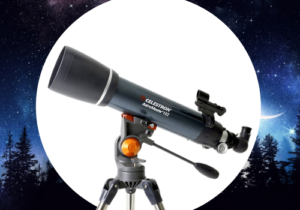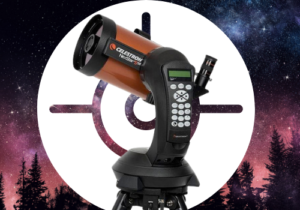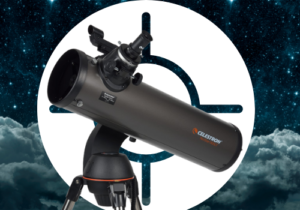Celestron Astromaster 114EQ Review; Only Good For Beginners
Disclosure: This post contains affiliate links and I may earn a small commission (at no extra cost to you) if you click through and make a purchase. Thanks in advance – I really appreciate it!
This article is a detailed review of the Celestron Astromaster 114EQ reflector telescope!
The Celestron Astromaster 114EQ telescope is mostly made for people who are just starting out in astronomy, so if you are looking to get the best night sky performance, then I should tell you beforehand to look somewhere else.
This is a beginner-friendly telescope that costs under $300 and has decent optics, which is good enough for a novice, but intermediates and professionals are not going to be satisfied with it.
You can check out these telescopes for viewing planets & galaxies if you want something better than Astromaster 114EQ.
My Verdict
The Celestron Astromaster 114EQ Telescope is a reflector telescope for beginners that will cost you less than $300. This being a budget telescope, it comes with certain design flaws that can not be ignored if you’re an experienced astronomer. Don’t expect the images to be like the ones in more expensive telescopes and photographs taken by professionals. It’s a telescope at the more affordable end that does a good job of giving beautiful views of the moon and the solar system. It comes with an erect image diagonal, so it can also be used for terrestrial viewing.The drawbacks found in this design are actual dealbreakers, and they can be dealt with if you have the patience or the know-how. if you’re a beginner and you’re not yet sure if stargazing is the hobby you want to further invest in in the future, then the Celestron 114EQ is the perfect pick for you.
Pros
- Affordable
- Decent aperture
- Fairly steady tripod
- Compact and lightweight
Cons
- Poor quality Bird-Jones Optical Tube
- Poor accessories
- Difficult to collimate
- Type: Newtonian reflector
- Aperture: 114mm (4.49″)
- Focal length: 1000mm
- Focal Ratio: f/9
- Mount: Equatorial
- Eyepiece: 20mm, 10mm
- Magnification: 50x, 100x
- Weight: 17 lbs (7.71 kg)
- Our Rating: 8.2/10
Prices pulled from the Amazon Product Advertising API on:
Product prices and availability are accurate as of the date/time indicated and are subject to change. Any price and availability information displayed on [relevant Amazon Site(s), as applicable] at the time of purchase will apply to the purchase of this product.
Celestron Astromaster 114EQ Review
Astromaster 114EQ’s Specifications
The primary mirror has a diameter of 114 mm and a focal length of f/8.6. The primary mirror also has a spherical curve, and it can give you a minimum magnification of 16x and a maximum of 220x.
Celestron chose an old Birds-Jones Newtonian optical design for this particular telescope, which makes the system less powerful than the newer Newtonian reflector designs.
In the end, this design causes a number of issues that you may not face in the majority of other telescope designs.
This catadioptric design, which was first made by Bird and Jones (hence the name), has a spherical primary mirror and a corrector lens placed right before the secondary mirror.
This design makes it possible to shrink the secondary mirror and make the primary mirror into a sphere that can be made cheaply.
It also gives the telescope a bulky size with a long focal ratio and almost no coma.
A very long time ago, when the Bird-Jones were invented, eyepieces were simple, and there were no coma correctors, so focal ratios used to be on the long side to get sharp images.
However, right now, with significantly better eyepieces, Bird-Jones isn’t ideal as it doesn’t work well with most modern accessories, although if it is done right, it’ll still be useful for beginners.
Another Design Flaw
Celestron has designed this telescope in a way that the corrector lens is actually placed inside the focuser.
This can cause two major issues while viewing.
First of all, this design flaw makes removing the corrector lens very difficult. Removing the corrector lens is an essential part of the collimating process if you want good sharp images.
Secondly, since the corrector lens is inside the focuser, this means that the distance between the corrector and the primary mirror is not fixed.
Instead, it depends on what eyepiece you’re using and how good or bad your eyes are. So the correction is always different depending on what eyepiece is used or even who looks through the telescope.
That said, The aperture size, magnification power, and focal ratio are all ordinary, which makes it a great balanced telescope.
It does not stray too far in either direction in terms of zoom and focus, meaning it is a great choice for a beginner astronomer.
The users on Amazon do seem to like the telescope for what it’s worth.
What Can You See With Astromaster 114EQ?
The optics on this telescope are not going to break any records or stretch the limits of the imagination, but they will be able to do a lot, especially for someone just starting.
The AstroMaster 114EQ can give you decent views of the Moon’s surface and Venus’ phases.
The Moon especially looks gorgeous with the 114EQ. Its rilles and mountain ranges are sharp and pleasing to look at.
It can even show you dark spots on Mars, along with an ice cap, if and when the planet is close to Earth.
Jupiter’s gas bands and its four biggest moons are easy to spot with Astromaster 114EQ, but unfortunately, you won’t be able to see the Great Red Spot.
This reflector telescope can also show you Saturn’s rings and a few of its largest moons.
When it comes to the deep-sky observations, the Andromeda galaxy can be spotted in greater detail, as can the Pleides and other star clusters.
Open star clusters like the Double Cluster are easy, while globular clusters only appear as fuzzy smudges.
Mount Performance
The mount Celestron supplies with the AstroMaster EQ telescope is known as the CG-3 equatorial mount.
The main benefit of the equatorial mount is that it can be aligned with the equator and used to track objects across the night sky for hours at a time.
This makes it easier to look at the sky for long periods of time than with a standard altazimuth mount.
The mount of this telescope has lots of plastic on plastic parts, and the metal parts get worn down immediately.
It has 1.25” tubular steel legs and lots of plastic castings on the tripod.
The telescope is attached to the mount by a standard dovetail with tube rings so that it can be placed on any compatible mount, such as the AstroMaster Alt-az mount or a larger equatorial Mount.
The equatorial mount can allow the user to learn how to track objects and align their telescope in a certain way to get the best results.
If you want to look at objects for longer than a few minutes in any given session, you are going to have to learn this skill.
The tripod is sturdy enough, and it comes with an eyepiece tray.
Astromaster 114EQ’s Eyepieces
The provided 20mm and 10mm eyepieces are good enough for planetary viewing, but for brighter deep-sky objects, like the Andromeda Galaxy or some star clusters, it can be too much magnification to get a wide enough field of view.
The 20mm eyepiece provides 50x magnification, and the 10mm eyepiece provides 100x magnification when used with this telescope.
The 20mm eyepiece is a poor-quality erect image eyepiece. Celestron includes this eyepiece solely so they can market this telescope to people looking to observe nature during the daytime, under the premise of the telescope being capable of terrestrial viewing.
If you do end up buying this telescope, I recommend replacing the 20mm eyepiece with a nice 25mm Plossl, or at least a 20-25mm Kellner.
Included Accessories
In order to keep the cost of this telescope down to beginner-friendly, Celestron does not include many accessories with it.
In addition to the tripod and mount, they have also included two eyepieces, Starry Night software, and a red dot finderscope.
The Red Dot Finder projects a red dot onto the sky. This type of red dot finder can be fun to use for a beginner.
Once aligned, the red dot will appear, seen through the finder’s window, as if it were projected onto the night sky with no parallax.
The telescope and its accessories are mostly made of plastic, so they aren’t the best quality, but they do what they’re supposed to do and are worth the price.
Alternative Recommendations
Even though most of the reviews on Amazon for the Astromaster 114EQ are positive, and it seems like it would be a good first telescope, it has a lot of problems that are hard to ignore.
The most obvious is the outdated Bird-Jones optical design and the awkward design that makes it hard to both align and sometimes look through.
If you’re thinking about investing in other telescopes, you can look at these beginner-friendly telescopes that cost less than $400.
If you want a low maintenance telescope that doesn’t need regular collimation, you check out these refractor telescopes.
If you’re someone with an interest in taking pictures of the night sky, you can check out this detailed article with reviews on the best telescopes for astrophotography for all budgets.
Conclusion
This telescope is certainly not perfect. It has a few issues that arise from its basic design.
All in all, it’s a mediocre instrument that is mostly saved by it being affordable.
For the price, this telescope has a wide variety of applications and can be used to see many different things in the night sky.
You can also learn a lot from it. A beginner can learn a lot with this telescope, from collimation to the right way to set up the tripod and tracking during long viewing sessions.
If you are looking for a telescope with decent optics at a reasonable price and are not afraid to learn on the job, then this telescope can be an excellent purchase for either a beginner or an intermediate astronomer.
Written by:

Jason Parnell
At 15, I sold my bike to buy my first telescope. I spent the next 3 years sketching as many Messier objects as I could find from my garden, then at the age of 18, I discovered beer. I have wandered through California's Mojave Desert with other amateur astronomers in search of the best stargazing experience.
ABOUT US
We are a team of active amateur astronomers, here to help you with all your astronomy and science related needs – this is anything, from reviewing the latest telescopes to be released to talking about gravity and neurons. The Big Bang Optics was started because of our love for astronomy and to help others like us find the best telescope and accessories.
LEGAL DISCLAIMER
The Big Bang Optics is a participant in the Amazon Services LLC Associates Program, an affiliate advertising program designed to provide a means for sites to earn advertising fees by advertising and linking to Amazon.com. The Big Bang Optics also participates in affiliate programs with Clickbank and other sites. The Big Bang Optics is compensated for referring traffic and business to these companies.




